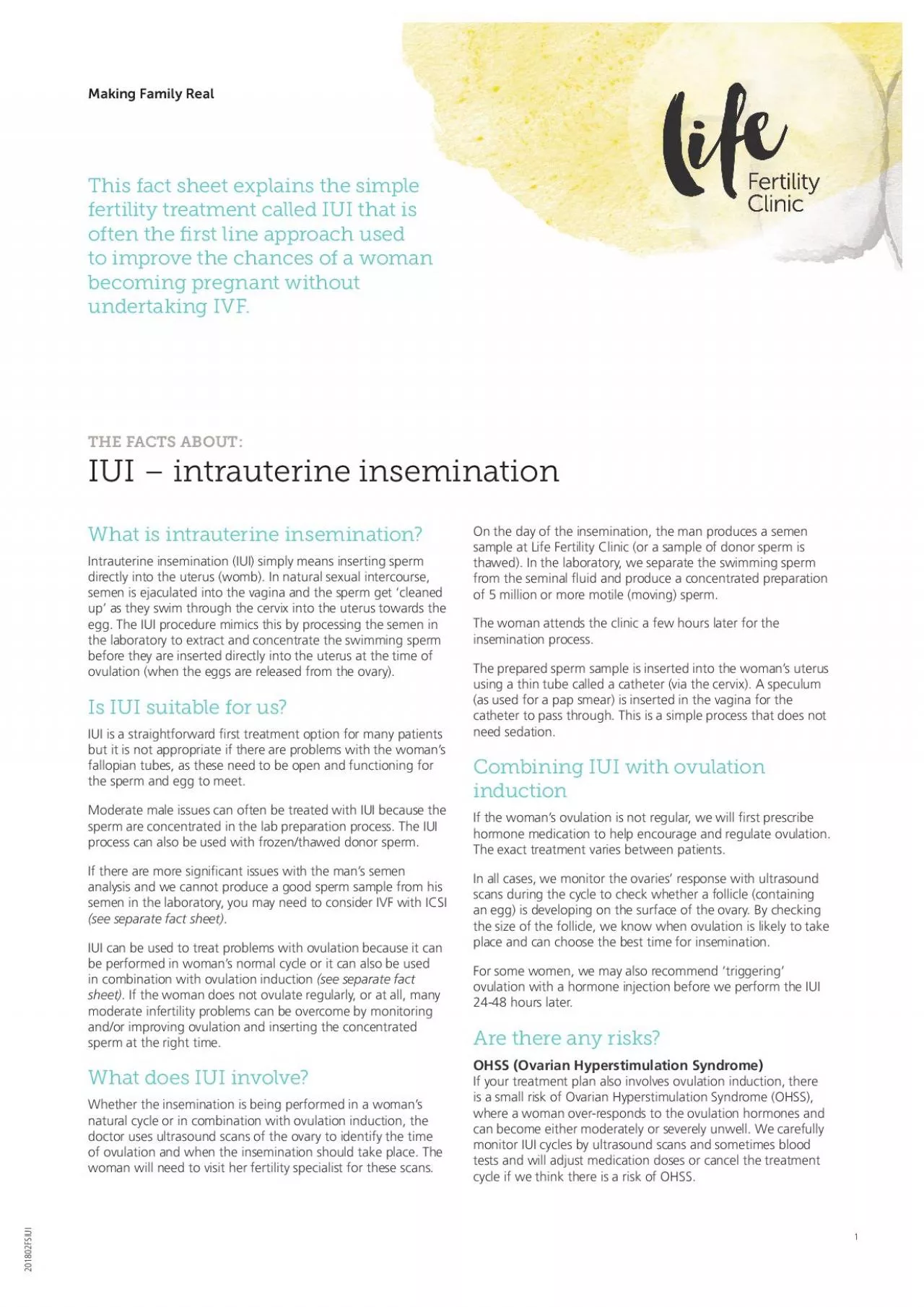

1 IUI 150 intrauterine insemination What is intrauterine insemination Intrauterine insemination IUI simply means inserting sperm directly into the uterus womb In natural sexual intercourse ID: 961770
Download Pdf The PPT/PDF document "THE FACTS ABOUT" is the property of its rightful owner. Permission is granted to download and print the materials on this web site for personal, non-commercial use only, and to display it on your personal computer provided you do not modify the materials and that you retain all copyright notices contained in the materials. By downloading content from our website, you accept the terms of this agreement.
1 THE FACTS ABOUT: IUI – intrauterine insemination What is intrauterine insemination? Intrauterine insemination (IUI) simply means inserting sperm directly into the uterus (womb). In natural sexual intercourse, semen is ejaculated into the vagina and the sperm get ‘cleaned up’ as they swim through the cervix into the uterus towards the egg. The IUI procedure mimics this by processing the semen in before they are inserted directly into the uterus at the time of ovulation (when the eggs are released from the ovary). Is IUI suitable for us? IUI is a straightforward rst treatment option for many patients but it is not appropriate if there are problems with the woman’s fallopian tubes, as these need to be open and functioning for the sperm and egg to meet. Moderate male issues can often be treated with IUI because the sperm are concentrated in the lab preparation process. The IUI If there are more signi cant issues with the man’s semen analysis and we cannot produce a good sperm sample from his semen in the laboratory, you may need to consider IVF with ICSI (see separate fact sheet) . IUI can be used to treat problems with ovulation because it can be performed in woman’s normal cycle or it can also be used in combination with ovulation induction (see separate fact sheet) . If the woman does not ovulate regularly, or at all, many moderate infertility problems can be overcome by monitoring and/or improving ovulation and inserting the concentrated sperm at the right time. What does IUI involve? Whether the insemination is being performed in a woman’s natural cycle or in combination with ovulation induction, the doctor uses ultrasound scans of the ovary to identify the time of ovulation and when the insemination should take place. The woman will need to visit her fertility specialist for these scans. On the day of the insemination, the man produces a semen sample at Life Fertility Clinic (or a sample of donor sperm is from the seminal uid and produce a concentrated preparation of 5 million or more motile (moving) sperm. The woman attends the clinic a few hours later for the insemination process. The prepared sperm sample is inserted into the woman’s uterus using a thin tube called a catheter (via the cervix). A speculum (as used for a pap smear) is inserted in the vagina for the catheter to pass through. This is a simple process that does not need sedation. Combining IUI with ovulat
ion If the woman’s ovulation is not regular, we will rst prescribe hormone medication to help encourage and regulate ovulation. The exact treatment varies between patients. In all cases, we monitor the ovaries’ response with ultrasound scans during the cycle to check whether a follicle (containing an egg) is developing on the surface of the ovary. By checking the size of the follicle, we know when ovulation is likely to take place and can choose the best time for insemination. For some women, we may also recommend ‘triggering’ ovulation with a hormone injection before we perform the IUI 24-48 hours later. Are there any risks? OHSS (Ovarian Hyperstimulation Syndrome) If your treatment plan also involves ovulation induction, there is a small risk of Ovarian Hyperstimulation Syndrome (OHSS), where a woman over-responds to the ovulation hormones and can become either moderately or severely unwell. We carefully monitor IUI cycles by ultrasound scans and sometimes blood tests and will adjust medication doses or cancel the treatment cycle if we think there is a risk of OHSS. fertility treatment called IUI that is often the rst line approach used to improve the chances of a woman becoming pregnant without undertaking IVF. 201802FSIUI Making Family Real 2 201802FSIUI Multiple pregnancy If ovulation induction is used, sometimes more than one egg follicle may develop. At Life Fertility Clinic we will not perform an IUI procedure if there are more than two mature follicles visible on the ultrasound because the risk of a multiple pregnancy is then high. How successful is IUI? IUI moderately improves your chances of a successful pregnancy. Around 10% of couples who have had dif culty conceiving are successful by this method. Because it is less expensive and less invasive than IVF, it is usually worth trying rst unless known problems make it unsuitable. If you do not achieve a pregnancy after three or four cycles, we will review the treatment and IVF may be necessary. Contact Life Fertility Clinic The friendly and professional team at Life Fertility Clinic are happy to answer any other questions you may have about the best treatment plan for you. Life Fertility Clinic ABN 72 161 525 774 St Andrew’s War Memorial Hospital Level 7 457 Wickham Terrace Spring Hill Queensland 4000 T 07 3606 3131 AH Emergencies 07 3839 8008 F 07 3606 3132 reception@lifefertility.com.au lifefertility.com.au